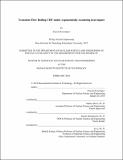| dc.contributor.advisor | Matteo Bucci. | en_US |
| dc.contributor.author | Kossolapov, Artyom | en_US |
| dc.contributor.other | Massachusetts Institute of Technology. Department of Nuclear Science and Engineering. | en_US |
| dc.date.accessioned | 2018-11-15T15:52:26Z | |
| dc.date.available | 2018-11-15T15:52:26Z | |
| dc.date.copyright | 2018 | en_US |
| dc.date.issued | 2018 | en_US |
| dc.identifier.uri | http://hdl.handle.net/1721.1/119047 | |
| dc.description | Thesis: S.M., Massachusetts Institute of Technology, Department of Nuclear Science and Engineering, 2018. | en_US |
| dc.description | This electronic version was submitted by the student author. The certified thesis is available in the Institute Archives and Special Collections. | en_US |
| dc.description | Cataloged from student-submitted PDF version of thesis. | en_US |
| dc.description | Includes bibliographical references (pages 41-42). | en_US |
| dc.description.abstract | Reactivity initiated accidents (RIAs) are a potential concern for nuclear reactor safety. In RIA scenarios, following the insertion of positive reactivity, e.g. by an unanticipated extraction of the control rods, the reactor power may increase exponentially. The period of the exponential rise, τ, depends on the amount of positive reactivity inserted, as well as the fuel composition. During such an event, boiling of the water coolant can provide not only an effective way of heat removal, but also a stabilizing, negative reactivity feedback. However, the reactor power could reach extremely high levels and lead to a boiling crisis, e.g. by departure from nucleate boiling (DNB), in turn leading to fuel damage. The aim of the current work is to improve the understanding of transient DNB phenomena. This goal was achieved by running experiments on a specially designed flow boiling platform, which includes high speed video (HSV) and high speed infrared (HSIR) diagnostics. Specifically, the IR radiation recorded by the HSIR camera was analyzed with dedicated post processing algorithms that enable measurements of the time-dependent temperature and heat flux distributions on the boiling surface. Experiments were performed on a flat heater in upward flow conditions at atmospheric pressure. This work explores the effects of flow velocity, liquid subcooling and exponential power escalation period on critical heat flux (CHF). The results show that, for our flow conditions, the CHF value does not depend on the escalation period for periods longer than 100 ms, and is essentially the same as in steady-state boiling. For shorter periods, CHF increases as the escalation period decreases, and the effect of flow velocity becomes less important at short periods. Larger subcooling was shown to increase the CHF at all conditions. For extreme cases of 50 K and 75 K of subcooling the entire heating surface was covered by tiny bubbles. Those bubbles had a very short (less than 50 [mu]s) lifetime and were quenched right after the nucleation. Such behavior prevented bubbles from coalescing and resulted in a very efficient heat transfer mechanism. CHF was observed at much higher values compared to steady boiling conditions, when nucleation site density and bubble size were large enough for the bubble to start coalescing. An interesting effect was observed for very short periods (5, 10 and 20 ms) and low subcoolings (10 K). At those conditions the boiling surface experiences CHF during the growth of the first generation of bubbles. Therefore, the points of ONB and CHF are almost coincident, with CHF delayed only by the time required for adjacent bubbles to coalesce and the microlayer underneath them to evaporate. | en_US |
| dc.description.statementofresponsibility | by Artyom Kossolapov. | en_US |
| dc.format.extent | 81 pages | en_US |
| dc.language.iso | eng | en_US |
| dc.publisher | Massachusetts Institute of Technology | en_US |
| dc.rights | MIT theses are protected by copyright. They may be viewed, downloaded, or printed from this source but further reproduction or distribution in any format is prohibited without written permission. | en_US |
| dc.rights.uri | http://dspace.mit.edu/handle/1721.1/7582 | en_US |
| dc.subject | Nuclear Science and Engineering. | en_US |
| dc.title | Transient flow boiling CHF under exponentially escalating heat inputs | en_US |
| dc.type | Thesis | en_US |
| dc.description.degree | S.M. | en_US |
| dc.contributor.department | Massachusetts Institute of Technology. Department of Nuclear Science and Engineering | |
| dc.identifier.oclc | 1059518385 | en_US |
